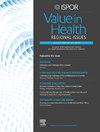Cost-Effectiveness Analysis of Mammography-Based Breast Cancer Screening in Indonesia
IF 1.4
Q3 HEALTH CARE SCIENCES & SERVICES
引用次数: 0
Abstract
Objectives
The Indonesian government has not implemented mammography as national screening program. Therefore, we evaluated the cost-effectiveness of mammography-based breast cancer screening strategy in Indonesia from a societal perspective.
Methods
The Simulation Model on radiation Risk and breast cancer Screening was used to examine various breast cancer screening scenarios, including different screening age (40-65 vs 35-65 years), frequency (every 2, 3, 4, or 5 years), and participation rate (50%, 70%, and 100%). The model’s input parameters were independently derived from published population statistics and systematic literature.
Results
Our findings indicate that, across all scenarios, mammography screening was cost-effective compared with no screening under the following conditions: (1) screening women aged 40 to 65 every 4 years at 50% participation rate, (2) screening women aged 40 to 65 every 4 years at 70% participation rate, (3) screening women aged 40 to 65 every 3 years at 70% participation rate, and (4) screening women aged 40 to 65 every 2 years at 100% participation rate. The incremental cost-effectiveness ratios these scenarios compared with the next best alternative were $4758 per life year gained (US dollars/LYG), $5263/LYG, $5436/LYG, and $7569/LYG, respectively, all of which were less than 3 times Indonesia’s gross domestic product per capita.
Conclusions
We recommend implementing mammography screening as a national program in Indonesia. The cost-effectiveness of screening strategies depends on factors such as participation rates, screening age, frequency, and the government’s willingness-to-pay threshold. We recognize Indonesia’s competing health priorities and limited resources. Acknowledging these priorities will help policymakers in making informed decisions about resource allocation.
印度尼西亚基于乳房x线摄影的乳腺癌筛查的成本-效果分析
目的印尼政府尚未将乳房x光检查作为国家筛查项目实施。因此,我们从社会角度评估了印尼基于乳房x光检查的乳腺癌筛查策略的成本效益。方法采用辐射风险与乳腺癌筛查模拟模型,对不同筛查年龄(40-65岁vs 35-65岁)、频率(每2、3、4、5年一次)和参与率(50%、70%、100%)的乳腺癌筛查情景进行研究。该模型的输入参数独立来源于已发表的人口统计数据和系统文献。结果在所有情况下,与不筛查相比,乳房x光检查在以下情况下具有成本效益:(1)40至65岁女性每4年筛查一次,参与率为50%;(2)40至65岁女性每4年筛查一次,参与率为70%;(3)40至65岁女性每3年筛查一次,参与率为70%;(4)40至65岁女性每2年筛查一次,参与率为100%。与次优方案相比,这些方案的增量成本效益比分别为每生命年增加4758美元(美元/年)、5263美元/年、5436美元/年和7569美元/年,均不到印尼人均国内生产总值的3倍。结论:我们建议在印度尼西亚将乳房x线摄影筛查作为一项国家计划。筛查策略的成本效益取决于参与率、筛查年龄、频率和政府的支付意愿门槛等因素。我们认识到印度尼西亚的卫生优先事项相互矛盾,资源有限。承认这些优先事项将有助于决策者就资源分配做出明智的决定。
本文章由计算机程序翻译,如有差异,请以英文原文为准。
求助全文
约1分钟内获得全文
求助全文
来源期刊

Value in health regional issues
Pharmacology, Toxicology and Pharmaceutics-Pharmacology, Toxicology and Pharmaceutics (miscellaneous)
CiteScore
2.60
自引率
5.00%
发文量
127
 求助内容:
求助内容: 应助结果提醒方式:
应助结果提醒方式:


